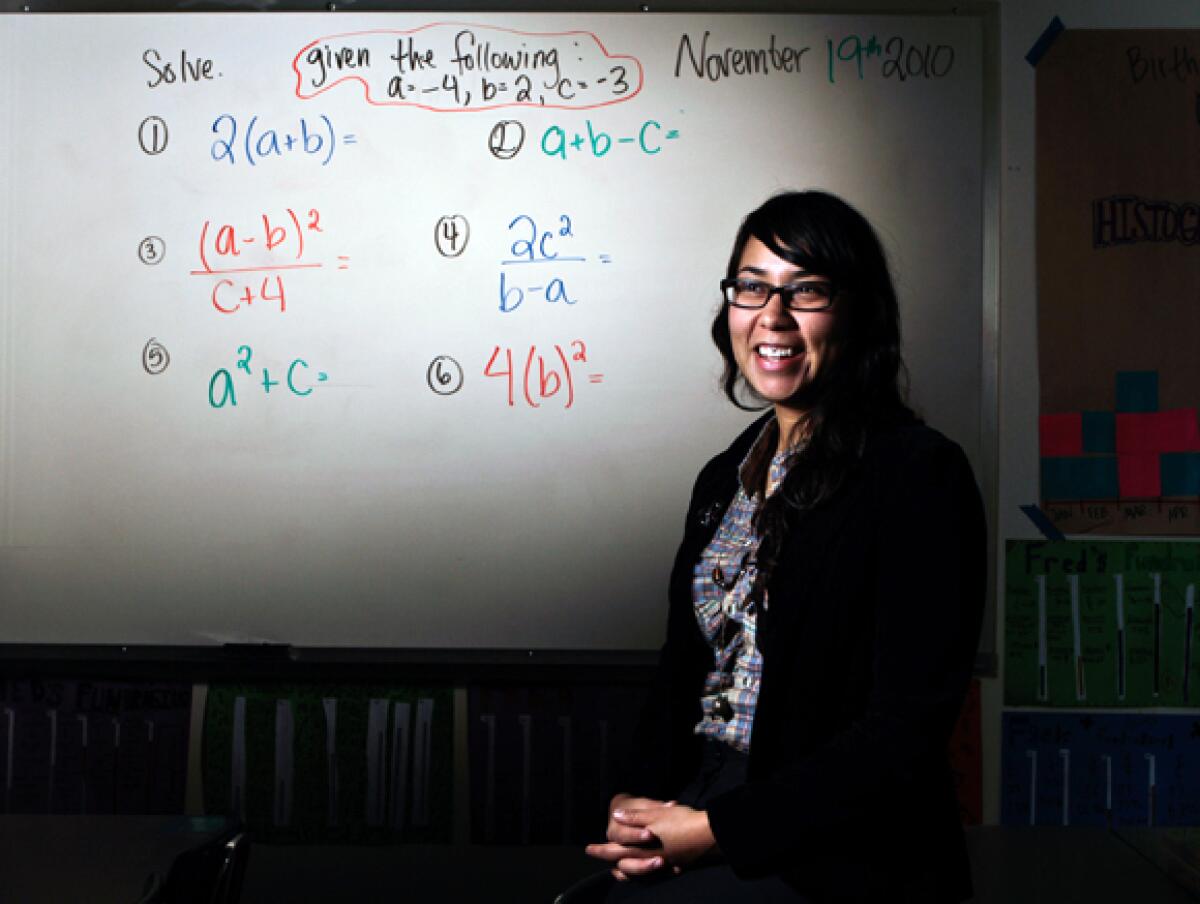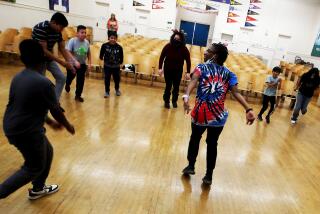When layoffs come to L.A. schools, performance doesnât count

John H. Liechty Middle School opened in 2007 in Los Angelesâ impoverished Westlake neighborhood with a seasoned principal, dozens of energetic young teachers and a mission to âreinvent educationâ in the nationâs second-largest school district.
The students had come from some of the lowest-performing schools in the city. But by the end of the first year, their scores on standardized tests showed the most improvement in English among district middle schools and exceptional growth in math, according to a Times analysis.
âIt was a dream job,â said Monique Gascon, who taught English and history at Liechty during its first two years. âWe had a lot of autonomy as teachers, we had a lot of support from administration and the kids were really learning. We could see the progress.â
But when budget cuts came in the summer of 2009 â at the end of the schoolâs second year â more than half of the teachers were laid off. Among those dismissed were Gascon and 16 others who ranked in the top fifth of district middle school instructors in boosting test scores, The Timesâ analysis found. Many were replaced by a parade of less effective teachers, including many short-term substitutes.
By the end of the last school year, Liechty had plummeted from first to 61st â near the bottom among middle schools â in raising English scores and fallen out of the top 10 in boosting math scores.
âEverything we worked those two years to instill is gone,â said Amanda Uy, a math and science teacher who was laid off and now teaches part time at a private school. âItâs really tragic.â
Quality-blind layoffs are just one vestige of seniority rules introduced decades ago to promote fairness and protect teachers from capricious administrators. Enshrined in state law and detailed in teachersâ union contracts, the prerogatives of seniority continue to guide many of the key personnel decisions made in public schools across the country, including pay and assignments. The effects are most keenly felt by students during layoffs.
The Times sought to measure the impact of about 2,700 seniority-based layoffs in the Los Angeles Unified School District in the last two years. It focused particularly on the performance of about 1,000 elementary and middle school teachers for whom math and English scores were available.
Among the findings:
Because seniority is largely unrelated to performance, the district has laid off hundreds of its most promising math and English teachers. About 190 ranked in the top fifth in raising scores and more than 400 ranked in the top 40%.
Schools in some of the cityâs poorest areas were disproportionately hurt by the layoffs. Nearly one in 10 teachers in South Los Angeles schools was laid off, nearly twice the rate in other areas. Sixteen schools lost at least a fourth of their teachers, all but one of them in South or Central Los Angeles.
Far fewer teachers would be laid off if the district were to base the cuts on performance rather than seniority. The least experienced teachers also are the lowest-paid, so more must be laid off to meet budgetary targets. An estimated 25% more teachers would have kept their jobs if L.A. Unified had based its cuts on teachersâ records in improving test scores.
The Times analysis relied on a statistical approach known as âvalue-added,â which estimates the effectiveness of teachers by crediting them for the gains students make over their performance in previous years on standardized tests in math and English. The approach is controversial because test scores alone are an imperfect measure of a teacher. Unions and some experts say it generates flawed results and encourages instructors to âteach to the test.â
But the approach has been embraced by the Obama administration and an increasing number of school districts across the country as one way of bringing objectivity to otherwise subjective evaluations â usually based on brief and infrequent observations by administrators. Even supporters say value-added should be used with other approaches such as reviews by fellow teachers or analyses of student work.
An increasing number of policymakers, educators and experts say performance â whether measured by value-added or other methods â must be considered if studentsâ needs are to take precedence.
âHow can we be doing whatâs in the best interest of kids if we donât even consider a teacherâs impact on kids when making key decisions?â asked Dan Goldhaber, director of the Center for Education Data and Research at the University of Washington.
The issue has gained momentum as tens of thousands of teachers nationally have been dismissed without regard to their abilities and research has established that veteran instructors on average are no better or worse than their less experienced colleagues.
From Washington state to Arizona to Rhode Island, seniority-based cuts have turned some young teachers against their own unions and fueled efforts â mostly unsuccessful thus far â to revise seniority rules. In California, two bills failed this year in part because of opposition from the California Teachers Assn.
At L.A. Unified, outgoing Supt. Ramon C. Cortines said he believes it is time to consider other factors besides seniority during cutbacks, including performance measures such as attendance and parental feedback. He said he favors capping the number of layoffs at a single campus â an approach similar to that proposed in a pending legal settlement involving Liechty and other schools.
Liechty, he said, is among middle schools that suffered deeply because their principals either recruited a high number of the âbest and brightestâ young teachers or were unable to find veteran teachers willing to work there.
âItâs not a fair situation for those schools, and they bore a very large burden,â Cortines said.
Pioneering campus
Liechty opened in the fall of 2007, its elegant main building of glass and steel standing out in a dingy neighborhood of apartments and convenience stores.
For its 1,900 students, it filled a gap: Middle schoolers for years had been bused to schools in other communities.
District officials recruited Jeanette Stevens, an experienced middle school principal, to carry out their ambitious plans. The students, most of them Latino and many still learning English, would be assigned to smaller groups within the school. Rather than switch classrooms and teachers for every subject, students in sixth and seventh grades would stay in one classroom and be taught by just two instructors, offering consistency and stability many did not have in their turbulent lives outside of school.
âWe were trying to reinvent education,â said Board of Education President Monica Garcia. âWe knew this community had bused out a generation of kids and had a 24% graduation rate.â
Stevens found that many veteran teachers were not interested in the schoolâs new approach. She filled more than half the openings with freshly minted teachers, many from UCLA and eager for the challenge.
Amanda Uy discovered that her eighth-grade math and science students were several years behind. âI asked them to raise their hands if they got an F in math last year,â she recalled. âThey all raised their hands.â
But in the teachersâ lounge, several instructors recalled, the chatter reflected a genuine optimism, a belief that all the students were capable of learning.
âIt was a combination of true believers and veterans who knew the situation and wanted to make a difference,â said Robert Barker, an experienced L.A. Unified teacher who volunteered to teach at Liechty.
Invigorated by their successful first year, teachers were partway into their second one when the budget crisis hit L.A. Unified. Pink slips went out across the the district, including 42 of the approximately 75 Liechty instructors, warning that they could be gone by summer.
Liechty teachers had been active union members, often attending protests at district headquarters. Now they wanted to know what their union would do to protect their jobs.
A quick letdown
When United Teachers Los Angeles President A.J. Duffy met with instructors in Liechtyâs library on a spring morning in 2009, their hopes for a reprieve were quickly dashed.
Saving your jobs would mean that more experienced teachers would lose theirs, Duffy said, according to interviews with several people at the meeting. Seniority is the only fair way to do it, he said, and any exception would be âan act of disloyalty.â
Teacher after teacher stood up to protest. âThere needs to be a different way of doing this,â Mike Kwok, a teacher with more than 30 years in the district, recalled saying. Allowing the layoffs to proceed âwould destroy not only these new teachers but also the community and the relationships they had built with the students.â
As Stevens watched, a call came in on her school radio. The superintendent was waiting for her in the office.
âPlease go tell your teachers that they will all have jobs here next year,â Cortines said, according to Stevens. âIâll do everything in my power to protect them and this successful model of reform.â
By the time Stevens got back to the library to deliver the message, Duffy was gone. Beaming, she shared Cortinesâ promise.
Many were skeptical. What could Cortines do to overrule state law, which, with few exceptions, required seniority to determine layoffs? Any solution would also require an exception to the union contract, and Duffy clearly wasnât willing to play ball.
Cortines did not dispute this account. Duffy said he went to the school knowing that teachers would âbeat me upâ and didnât recall saying anything about disloyalty.
The union president said he told teachers there was no evidence that new teachers do better than veterans; moreover, seniority-based layoffs were part of union policy.
Throughout the spring, the district sought concessions from the union and looked for loopholes in the law. Teachers organized demonstrations and hunger strikes. At Liechty, teachers wore pink to protest their pink slips and held a sleep-in in front of the school for several nights.
The turmoil took a toll. Students began asking instructors if they would be around the next year.
âIt wasnât just teaching. It was worrying about what was going to happen to me and my kids,â said Arlen Vidal, a top-ranked math teacher who now teaches at a private school.
Come July, nearly 2,000 district teachers were let go, including nearly all of those who had been pink-slipped at Liechty â demolishing the stability the school had been designed to foster.
Under an eleventh-hour deal between the district and the union, the laid-off teachers were offered priority as long-term substitutes, who often earn less money and get no sick days. The deal â which Cortines later acknowledged was a âBand-Aidâ â sidestepped the seniority rights of those substitutes already on the list, provoking them to protest against the union and district.
Duffy said the unionâs compromise was an attempt to protect students.
But even many of those whom the deal was supposed to help were unhappy. At Liechty, about half the laid-off teachers decided theyâd rather leave.
Filling vacancies
By the time school started in September 2009, Liechty was still desperately trying to find replacements. Stevens herself was leaving to lead a struggling high school in San Pedro. Before departing, she tried to fill the jobs but found few teachers willing to take them.
Many of the candidates were elementary teachers whose positions had been eliminated to save money. Under the rules, they had enough seniority to avoid a layoff but had to be placed elsewhere.
Many had little interest in teaching challenging middle school kids in a poor community, Stevens said. Of those who did accept jobs at Liechty, some left in tears within days or called in sick every day, teachers recalled.
âThe teachers who were hired didnât want the jobs, and those who wanted them werenât allowed to teach,â recalled Barker, who ranked in the top fifth of middle school teachers and quit in frustration.
Many classrooms had as many as 10 subs over the year, often with no credentials in the subject they were teaching, staffers said.
âI got these calls saying, âYour class is falling apart,ââ said Judy Kerber, a laid-off Liechty teacher also in the top fifth of middle school instructors districtwide. âThis amazing group of kids just fell apart.â
More fights broke out on campus, drug use increased and youngsters became more unruly in class, several students and teachers recalled.
âIâd visit them and see that books were destroyed, their classroom was vandalized,â Gascon said. âI could lecture them ⌠but I understand how they feel. They feel like theyâve been abandoned.â
Kwok, who was not laid off but retired at the end of last year, saw it too. âIt became like a game,â he recalled. âThe kids knew what was going on, theyâd test the teachers, push as many buttons as they could.â
Eighth-grader Helen Arias said students knew the teachers werenât going to stay long, âso why should they pay attention?â
Last year, Arias said, she had three short-term substitutes in math at the beginning of the year. One of them had the class fill out multiplication tables every day for half an hour. The rest of the class was spent going over the results.
âWe knew what 12 times 2 is,â Arias said. âWe didnât make any progress.â
In late 2009, the district warned of a second round of cuts. Thousands more could be let go â including some Liechty teachers who had been hired back as long-term subs.
Three months later, lawyers representing several students at Liechty, Edwin Markham and Samuel Gompers middle schools sued the district, arguing the seniority-based cuts had violated studentsâ constitutional rights to an equitable education.
A judge granted a preliminary injunction in May, temporarily preventing further layoffs at those schools. District officials have agreed to a settlement that would ensure that layoffs, though still based primarily on seniority, would be spread more evenly across the district.
But the settlement â opposed by the union â would do nothing to restore jobs already lost.
Gone for good
Disillusioned, many of the talented young Liechty instructors have sworn off ever returning to L.A. Unified.
At least two are in law school. Gascon, the English and history teacher who ranked high in The Timesâ analysis, subbed as often as she could at Liechty, then quit the district to travel the world.
âI know I want to teach again, but Iâm not coming back to LAUSD,â she said in a telephone interview from Cape Town, South Africa.
Randell Erving, a top-ranked Liechty teacher, now works as a residential director at Chapman University in Orange.
âThey donât consider what kind of a teacher you are, so itâs hard to have a lot of trust in the district,â said Erving, who quit after receiving a pink slip and said he would go back only if he could work with a principal like Stevens.
Across the district, other laid-off teachers expressed similar sentiments.
âI gave up on the district,â said Artineh Navasartian, a top-tier elementary school teacher who was laid off in 2009 and now works at a private school. âI didnât want to sit home for another year waiting for the call.â
This year, budget cuts at the nationâs schools could be even deeper. About 5,000 positions may disappear at L.A. Unified unless new money arrives or a deal can be reached with the union, according to recent projections.
Duffy said he is willing to discuss changes to the seniority policy and is even open to considering standardized test scores as one performance measure, but only if students, as well as teachers, are held accountable for the test results.
At Liechty, meanwhile, students are still struggling to recover.
âWe do the same lesson over and over again,â said Jana Medina, an eighth-grader who has had three substitute teachers in history alone. âI feel like Iâm not learning anything.â
Jana got a C in history last year in a different middle school, according to her report card. Last term she got an F. Her mother, Lourdes Gonzalez, said she went to talk to one of the substitutes, but the teacher barely knew who Jana was.
âWe live in a very hard area,â Gonzalez said. âThe only way to break out is through education, and sheâs not getting a good one now.â
doug.smith@latimes.
Times data analyst Sandra Poindexter contributed to this article.
More to Read
Sign up for Essential California
The most important California stories and recommendations in your inbox every morning.
You may occasionally receive promotional content from the Los Angeles Times.












